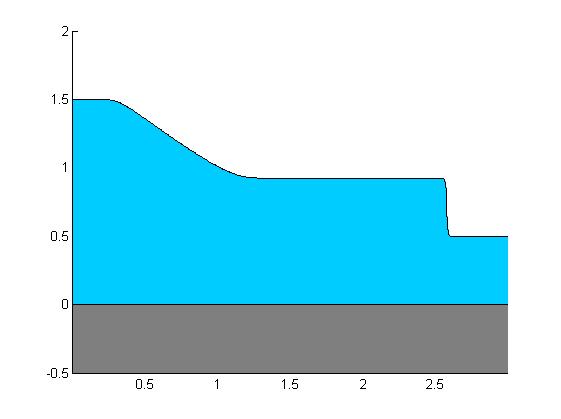| %A simple example to simulate a dambreak in 1D %basic instruction to write a VolcFlow file nrow = 3; %equations are in 2D. At least 3 lignes (or columns) should be defined, even for 1D simulation ncol = 500; %number of column of the simulation dx_horiz = 3/ncol; %defines the space step (in m) as a function %of the domain length and the number of cells chosen dy_horiz = dx_horiz; %space step in y dt=0.001; %time step (in s) dtplot = dt*50; %time step for plot tmax = 0.3; %duration of the simulation (s) tstep_adjust = 0; %0 = the time step is fixed by the user, 1 = its varies in time using a CFL condition g=9.81; %gravity (m/s2) delta_int = 0/180*pi; %internal friction angle (for Coulomb behaviour). Set to 0 here. (rad) delta_bed = 0/180*pi; %external friction angle (for Coulomb behaviour). Set to 0 here. (rad) cohesion = 0; %cohesion or yield strength (depending of the rheology used), Pa rho = 1000; %density (kg/m3) viscosity = 0; %dynamic viscosity in Pa s representation = ‘cla; patch( »xdata », [x(1) x x(end)], »ydata », [0 h(2,:) 0], »facecolor », [0 0.8 1]); patch( »xdata », [x(1) x x(end)], »ydata », [-0.5 h(2,:)*0 -0.5], »facecolor », [0.5 0.5 0.5]); axis([x(1) x(ncol) -0.5 2]);‘; %function used for the visualisation of results (at each dtplot) f_avi = »; %avi file done with the plots. » = no movie is done f_data = »; %save various variables at each dtplot. » = no data is saved %boundary conditions should be defined for 1D simulation bound_cond = ‘h2(1,:)=h2(2,:); h2(nrow,:)=h2(2,:); u_xx(:,1)=0; u_xx(:,ncol-1)=0; u_yy(1,:)=0; u_yy(nrow-1,:)=0;’; %definition of the initial thickness h(1:nrow, 1:ncol)=0.5; h(1:nrow, 1:ncol/2)=1.5; %initial topography: flat, z=0, same size than h z = h*0; %vectors x and y – not needed by VolcFlow (for the visualisation of results only) x = [dx_horiz/2:dx_horiz:ncol*dx_horiz-dx_horiz/2]; y = [dy_horiz/2:dy_horiz:nrow*dy_horiz-dy_horiz/2]; %initial velocity – 0 here u_xx = z(1:nrow, 1:ncol-1)*0; u_xy = z(1:nrow, 1:ncol-1)*0; u_yy = z(1:nrow-1, 1:ncol)*0; u_yx = z(1:nrow-1, 1:ncol)*0; |



